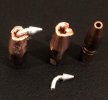I was hoping would get around to lethality. We have approached our bullet design from a different persoective. I am a surgeon by training specializing in urology. During my first 2 years of residency I spent at least half at a level 1 trauma center, SF General Hospital, and got to see a wide variety of penetrating and blunt trauma. The most lethal wounds were either penetrating trauma to the vena cava or blunt trauma to the heart. The mechanism of death was always severe low blood pressure either because the bleeding could not be contained, as in the case of vena cava tears or pump failure from severe bruising of the heart muscle as in the case of blunt injury to the heart, hitting the steering column in an auto accident for example. In hunting big game, a catastrophic drop in blood pressure causes rapid unconsciousness because of lack of brain perfusion. An expanding bullet hitting the top of the heart will take out both the main pulmonary artery and aorta causing an immediate catastrophic hemorrhage with resultant immediate and profound drop in blood pressure with cessation of brain activity. The animal is dead right there. Shots through the mid to rear chest are fatal eventually but are not likely to lead to catastrophic blood loss. If both entrance and exit holes are small, what happens is that as the animal inhales, air leaks out into the space called the pleural cavity, causing a gradual buildup of air pressure around the injured lungs that collapses them under pressure causing all blood flow through the lungs to stop, C causing a drop in heart output and blood pressure to the point that the brain stops working and the animal collapses. If the exit hole is large then air pressure does not build up in the pleural space and prevents the complete collapse of the lungs without a rapid drop in blood pressure. The animal can run a considerable distance and die later from exhaustion, infection, or predation, Copper, being considerably harder than lead, will not deform unless the front of the bullet is weakened by a hole. Expansion of the bullet is poor unless there are groves cut into the wall of the hole which act as stressors and allow the copper to tear along those groves, causing the petals to be formed and rolled back. Since the bullet is also spinning about it's longitudinal axis at over 200,000 RPM, these petals act like propeller blades and assist the bullet in penetration. The high forward velocity of the expanded bullet causes a large temporary wound cavity behind the bullet. Non-expanding FMJ bullets just pencil through causing much less tissue damage and much smaller temporary wound cavities. Weight retention is high which adds to the momentum of the bullet, thus adding penetration. The expanded front end also contributes to a straighter path and prevents tumbling. Expansion is around 1.5 calibers. The high BC of our bullets extends the range before minimum expansion velocity is reached. At very high impact velocity, at least in gel, the petals can shear off usually within 10-12 inches snd subsequent tumbling of the shank. No expansion scheme can compensate for a poorly placed shot however.
Photos are of various bullets showing the type of expansion they have in 10% gel.






